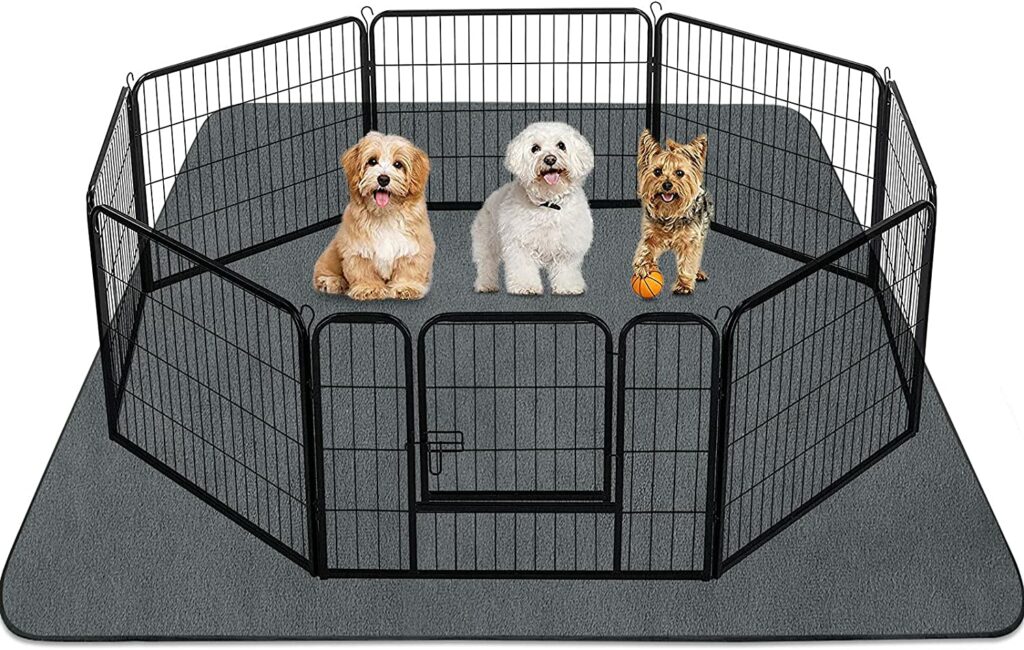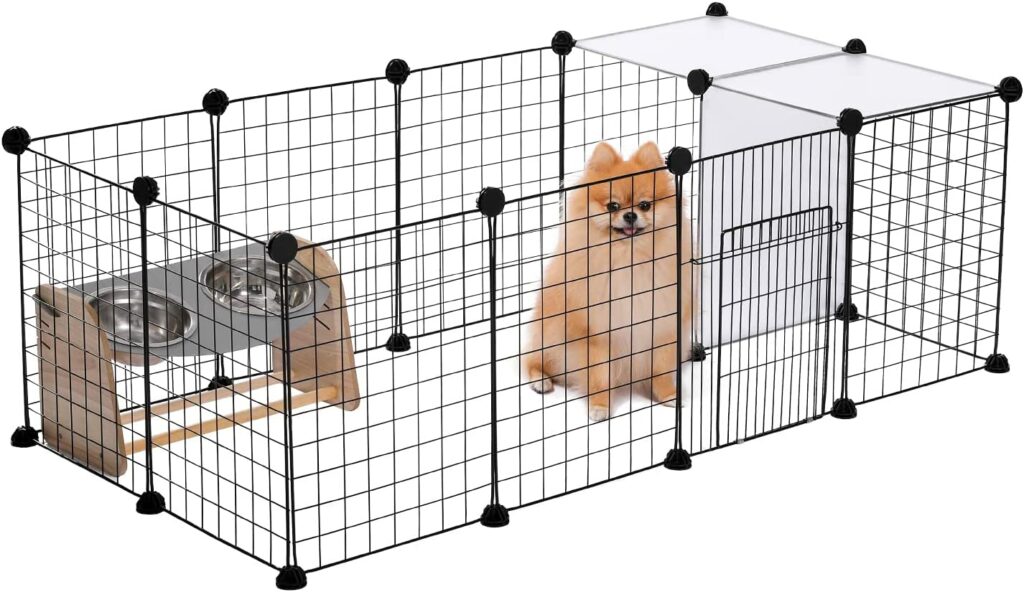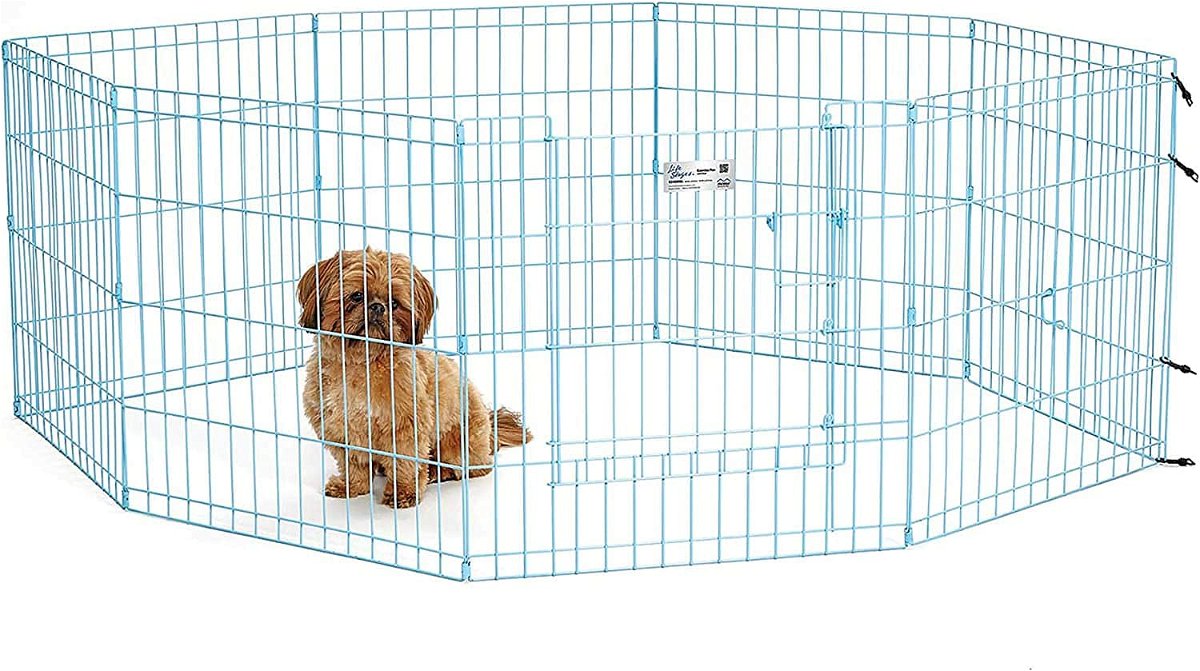We're an affiliate
We hope you love the products we recommend! Just so you know, we may collect a share of sales or other compensation from the links on this page at no additional cost to you. Thank you if you use our links, we really appreciate it!
Puppy playpen training is the process of using a pen to train your puppy in developing good habits and skills that will make them reliable in their adulthood.
Such training lessons may include basic commands & obedience training, socialization, and potty training.
One of the major benefits of using a playpen to train your puppy is that they can give you full attention while inside. This is especially useful for hyperactive pups who can’t settle in one area at a time.
Having them safely contained in a small space will make them easy to teach and guide during the training sessions.
Keep reading this post to find out all you need to know about puppy playpen training and why you should emulate it to make your young pooch a well-behaved adult pup.
Setting Up the Playpen
Setting up your puppy’s playpen is an important part of determining how quickly they settle in and how successful the training will be.
1. Choosing the right size
You should always choose a puppy pen that is of the right size and type for your young pooch. It should be spacious enough to give them a free space to turn around and play, but not too big for them.
2. Time to spend in the playpen
Before putting up your puppy’s pen, you also need to consider the time your puppy will spend in the pen and for how long.
Is it 20 minutes, 1 hour, or 6 hours? The choice is yours and it should be guided by your desired training procedure and guidelines.
If you are planning to use the item as a containment area for your puppy, you should be careful enough not to let them stay inside for an extended period.
3. Placement of the playpen
Depending on how often you will use the playpen, you need to choose a suitable room to set the pen panels up.
The room should be easily accessible for all members of the family with a clear corridor leading to the door.

Choosing a cramped room will make it difficult for the dog to focus on the training and you might be hindered from continuously supervising your pup during the process.
We recommend getting a ventilated, well-lit space free from house hazards such as electrical cords.
The calmness of the room will depend on the lessons you are going to give your puppy. If you are planning on command training, then the area should be silent and free from distractions.
4. Furnishing the playpen
Remember to furnish the pen with some basic items to keep your puppy safe and comfortable. Such may include:
- A potty area
- Food and water bowls
- A cozy bed
- Interactive dog toys
Introducing Your Puppy to The Playpen
Introducing your puppy to the playpen is perhaps the most important step in their training and containment.
If you get this wrong, then your young pooch might associate the pen with a bad experience and you might take longer to get this process done.
The following step highlight various stages in introducing a puppy to a playpen:
- Take the puppy for a brief walk around your yard then come back for a bathroom break. This will get them excited and would also prevent them from making accidents during the introduction process.
- Open the playpen door and let your puppy get inside on their own terms. If they are seemingly afraid of taking the first step, you can carry them softly and lead their way.
- Do not close the pen’s door at this point. You would want your young pooch to leave and re-enter the playpen at their own will. Shutting the door immediately might frighten your puppy when they realize that they are in a confined area.
- Give them a tasty piece of their favorite treats and some toys to play with while inside.
- Once your young dog seems comfortable with their new accessory, you can close the door while they are inside and hang around the room for a few minutes.
- Leave the area for about 1 minute then come back and release your puppy. This will teach your dog that the playpen is an area they can spend some time alone while having all they need.
- Repeat the procedure above while increasing the separation interval before releasing the pup from the playpen. You can make it more progressive after about 2 days by leaving your house and going for short errands around the neighborhood.
Remember that it is completely normal for puppies to whine during the first occasions of being left alone.
You should however not give them immediate attention when this happens. Allow them to tone down their yelping before reaching out to them.
If you respond immediately to their first cry, they will quickly learn that whining is a sure way of getting them out of a contained area.
The secret to a successful introduction is to make the process slow and progressive. All pups are different and yours might take a bit longer or shorter than expected to get the process done.
Puppy Playpen Training Techniques
A puppy pen offers a great space to provide training for your furry friend. The following are some of the common techniques you should apply today:
1. Potty training
Potty training your puppy is teaching them to pee in the right area. What better way to do this than using a playpen?
Step 1: Get the right-sized playpen. The ideal one should allow your little pup to stand, make a few turns and sit down with comfort.
Getting a large playpen will only make potty training more difficult because your dog would have a large space to mess around. We recommend getting a playpen with adjustable panels for ease, convenience, and versatility.
Step 2: Set up your playpen in an easily accessible area and cover the bottom surface with puppy pee pads. This will protect your floor from accidents and they are much easier to clean after.
Step 3: Take your puppy to the allocated potty area when they need to go out. You can watch out for the signs that your puppy needs to pee including; being restless, sniffing around, squatting, whining, and circling.
Most puppies are also prone to go out during certain times of the day including: Before sleeping, immediately after waking up, after meals, after their daily exercises, or after drinking water.
Step 4: Make sure to reward your puppy every time they pee on their designated spot in the pen. These rewards could be soft treats, chews, or praises and petting.
This will help them in creating a positive association with what they have done and they will try to repeat for more rewards in the coming hours.

We encourage you to apply patience and be consistent in training your pup on good bathroom behavior. Stick to a regular schedule and make sure the pen is in the same spot throughout the training period.
Puppies are prone to make accidents even during potty training. You should not punish Fido for making a mess on your carpet or furniture. Invest in a good pet odor eliminator that will help you drive out the stink as you concentrate on the bigger picture of training your young dog.
2. Teaching basic commands and obedience
You can use a playpen to train your puppy to respond to basic commands and become obedient as they grow into adulthood.
A well-behaved and responsible dog who knows their boundaries is the type of pet that every dog parent would love to own.
You can use a puppy pen to teach your dog basic commands such as ‘sit & stay’, ‘come‘, ‘run’, ‘go’, and much more.
The tool gives you a controlled environment to teach your dog basic instructions while monitoring their progress.
3. Providing Mental Stimulation and enrichment
A puppy pen is a good space for stimulating your little pup’s brain powers and enriching their intelligence.
A mentally stable dog is less likely to develop stress & anxiety alongside destructive behavior such as excessive chewing.
Give your puppy some interactive puzzle toys in their playpen and let them get fully occupied and stimulated as they figure out the games.
A pen provides a good space for providing such toys for your puppy because they help them remain focused on their games and goals.
The bounded space also restrains some toys from moving all over the place as this could be overwhelming for your puppy to figure out.
Gradually Increasing Time in the Playpen
If you are using the playpen as a containment tool for your puppy, you should never leave them inside for too long.
This can make them bored to tears by becoming distressed and developing canine separation anxiety among other related problems.

Always start by putting your puppy in the playpen for short periods as you increase the time little by little.
The increase in time and separation should also be guided by how comfortable and settled your little pooch seems in the pen.
The maximum period (in hours) to keep your puppy in the pen should directly correspond to their age (in months). A 5-month-old puppy should for instance spend a maximum of 5 hours inside the playpen.
Frequently Asked Questions (FAQs)
1. Leaving the puppy in the playpen overnight. Is it OK?
It is okay to leave your puppy in the playpen overnight only when you are in the same room with them and their pen is fitted out with a comfy dog bed.
This will give you an easy time to monitor them and check if they have any issues or need to go out during the wee small hours.
Make sure to empty their food and water bowls in the pen as they could easily eat too much or spill everything which can lead to a mess.
If the playpen is in a different room, then it is not recommended to leave your puppy in it throughout the night.
They could easily get anxious or develop behavioral issues when they stay lonely for extended periods.
2. When to stop using a puppy pen?
At some point, your puppy will no longer need a pen, but this will depend on their individual progress in housetraining.
Once your puppy becomes fully potty-trained and can respond to basic commands, then you can start to slowly phase out the playpen.
You can continue using the item for temporary containment when you are away even after fully training your puppy.
But once your dog gets to 1 or 2 years and older, then you can consider them adults and they should be able to maneuver their way inside the house.
In Summary
Puppy playpen training is a good way to help your little pooch develop good traits in becoming a responsible adult.
Puppy pens provide a safe and contained area to teach your dog and allow them to play and rest when needed.
Just be cautious to keep the training sessions short and enjoyable for the puppy. Increase the time gradually while monitoring the progress of your little champ.
Remember that patience is everything when dealing with pets and always stick to a regular pattern to help your puppy learn things quicker.
Laura is the founder of Furs'n'Paws. She is a also a pet writer and expert with more than 20 years of experience of working with dogs and cats. She developed a very strong love for animals at a young age. Her passion led her to establish a thriving pet sitting and dog walking business in Dubai. As an expert in pet training, behavior, and nutrition, Laura is committed to helping pet owners and pet lovers by offering high-quality information on a wide range of topics.



No responses yet